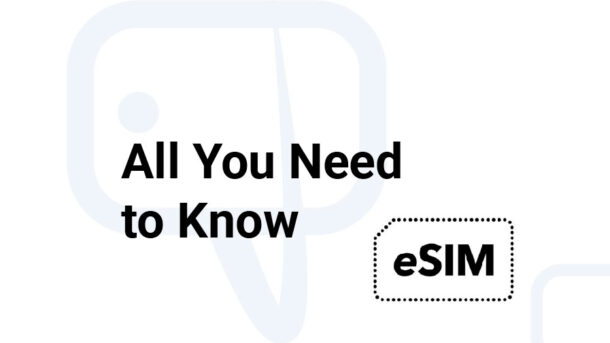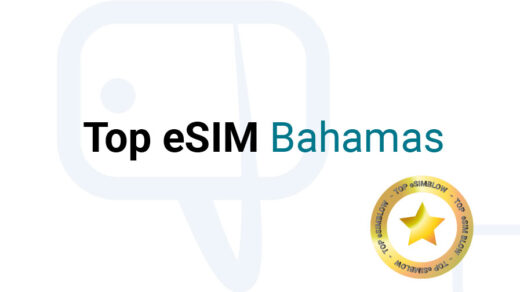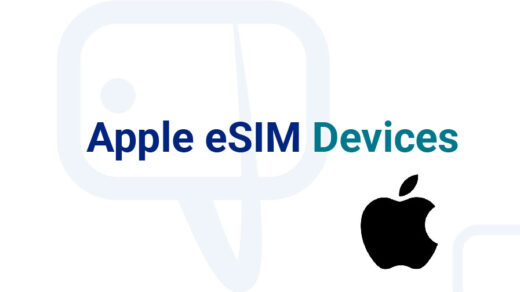Since the launch of the SIM card in 1991, it had not had significant changes. Most of them were focused on reducing the form factor : mini SIM, micro SIM and nano SIM.
Now, with the arrival of the eSIM and its implementation in various mobile devices, the change goes beyond size and focuses on the environment, security and new connected technologies.
In this post, we are going to address the eSIM from its history and everything you need to know to understand it and start using it on your compatible mobile devices.
Table of Contents
- What is an eSIM?
- How eSIM technology works
- Storage capacity
- Sizes
- How the ICCID works in the eSIM
- Can an eSIM be cloned?
- What happens with the MultiSIM service
- Where do you get an eSIM?
- How is it installed?
- How to activate?
- Advantages
- Disadvantages
- History
What is an eSIM?
An eSIM, or embedded SIM card, is a type of SIM card that is built directly into a device, such as a smartphone, tablet, or smartwatch. The acronym “eSIM” means ” embedded SIM ” in English, which translates as ” embedded SIM card .”
Other names
Just as the SIM card receives different names depending on the country or region, the eSIM also has its variations. Among them are:
- Virtual SIM: it is usually used in countries such as Colombia and Spain.
- Virtual chip: it is common in countries like Mexico, Peru and Brazil.
- Digital SIM: this term is used in several countries.
- Electronic SIM: Apple uses this name.
How eSIM technology works
In simple terms, eSIM requires three components: an eSIM provider, a device, and an end user.
1. eSIM provider
The eSIM provider is the mobile phone or telecommunications company that will provide the Internet, SMS or call service to the customer.
The telephone company must have the technology to make the change from physical SIM to eSIM.
2. Compatible device
For the eSIM offered by the provider to work, a compatible mobile device is required. Today there are hundreds of them, although most at high prices.
A mobile phone compatible with eSIM means that the phone has inside the chip that will store the profile or profiles that you download from the provider .
The interface or integration method of the eSIM varies according to the type of device. In some cases the customer must manually install the eSIM, however, in other cases the compatible device works centrally and the customer does not have control of their eSIM.
3. End user
It is the person who uses the SIM and who requests it from the eSIM provider. In most cases, he is also the one who installs the eSIM on your device, based on the instructions provided by the provider.
Storage capacity
The storage capacity of an eSIM depends on the manufacturer, some have 256 KB, others offer 512 KB, and they can even have 1GB of space.
The number of profiles that can be installed on an eSIM is also influenced by the size or weight of the profile required by the provider.
Sizes
The size of the eSIM varies depending on the manufacturer. Generally, eSIMs have a size of 6mm x 5mm and a thickness of less than 1mm.
The French company Thales makes eSIM cards that have a size of 2.5 mm by 2.3 mm and a thickness of just 0.2 mm.
How the ICCID works in the eSIM
The ICCID (Integrated Circuit Card Identifier) is a number that allows you to identify a SIM card. With this identifier you can know the country and the network operator.
It also allows identification of the SIM card when it connects to the network, its authentication and registration on the network.
Now, the operation of the ICCID in the eSIM is the same as in the SIM. When you activate an eSIM, the provider can give you a printed QR code where the ICCID is also located, this number usually starts with the number 89.
The ICCID of an eSIM can also be found by going to the “ About ” section on your Apple or Android device.
Can an eSIM be cloned?
Although it is more complex than cloning a physical SIM, it is possible to clone an eSIM. Each eSIM card contains an IMSI and an authentication key ( Ki ) that allow the user to be authenticated on the network. These data are like the SIM username and password to use the services of the mobile phone company.
If a hacker manages to know the IMSI and decrypts the access key (Ki) he could impersonate an eSIM.
Unlike SIM cards that need to be copied physically, the cloning of the eSIM will be digital. In this way, the security of the eSIM falls mainly on the mobile operator.
What happens with the MultiSIM service
MultiSIM is a service that allows you to use a single plan on different devices that support a SIM card. Limits on the number of SIM cards and compatible devices depend on the operator.
Some companies offer MultiSIM service through Apple Watches. These devices have an eSIM inside, which allows you to take advantage of the MultiSIM service.
You must keep in mind that activating MultiSIM with your operator may have an extra price.
You cannot use an eSIM on multiple devices at the same time . There is also a limit on the number of times you can use the installation QR code.
Where do you get an eSIM?
The channels to request or acquire an eSIM vary according to the use that will be given to it, the device and type of contract.
Most mobile phone companies in the world require those interested in changing their SIM card to eSIM to go to their stores or service centers . The same thing happens when you want to sign up for a new plan using an eSIM.
It is also possible to purchase eSIM through eSIM managers who facilitate the process.
Another option available are applications in stores such as the App Store or Play Store.
How is it installed?
Installing an eSIM requires an Internet connection, installation media provided by the provider, and a compatible mobile device.
When the installation is M2M (Machine to Machine), it is required to sign a contract or agreement with the supplier and this will be the one who centrally carries out the installation and management of the eSIM.
eSIM Quick Transfer
It is a service offered by Apple that, in addition to other functions, allows you to convert a SIM card from an operator to an eSIM. This option is only available with some companies.
eSIM Carrier Activation
Like eSIM Quick Transfer, the eSIM Quick Transfer feature is offered by Apple on some carriers. It allows you to install an eSIM on an iPhone, which is pre-installed at the factory.
QR code
It is one of the most common methods. It is available for most mobile devices, except Apple Watch. In this case, the user scans a QR code with their device’s camera and proceeds to the installation.
Manually
In this case, the eSIM provider must provide the user or customer with an SM-DP+ address and an activation code. This information must be entered manually on the mobile device to begin the installation.
How to activate?
eSIMs can be activated automatically after being installed on a device. Sometimes you have to wait a few hours for them to start working.
Some mobile phone companies require the eSIM to connect to the network to activate.
Advantages
The advantages of the eSIM are the following:
- Reduces the amount of waste due to its use: unlike SIM cards that require RRP to be produced, the eSIM is embedded in the mobile device and can store multiple profiles during its life cycle.
- Provides flexibility to the consumer: anyone who has an eSIM compatible device has the possibility of downloading several eSIM profiles and using them according to their convenience.
- Promotes the Internet of Things (IoT): being natively integrated and its small size facilitates the creation of gadgets connected to the Internet. Furthermore, with the possibility of M2M installation, the user has greater freedom when choosing the provider of this service.
- Easy to transfer between devices: Apple, Samsung and Google Pixel have developed methods to make it possible to move an eSIM from one smartphone to another that is nearby.
Disadvantages
Surely these disadvantages will be eliminated in new versions. For now the most notable disadvantages are:
- Damage is not allowed: if your phone is damaged, you will need to go to the operator’s store to cancel that eSIM and give you a new one. If you prefer to wait for the repaired phone to be returned to you, it has the disadvantage of losing control of your plan and it could be used by unknown people.
History
The milestones and important events in the history of the eSIM have been given as follows:
2016: Samsung launches the Gear S2 classic 3G smartwatch, the first smartwatch to come equipped with eSIM.
2017: Google launches the Google Pixel 2 and 2XL, both equipped with eSIM technology. Although they had the restriction of use only with the Google Fi operator.
2017: Apple includes the eSIM in the Apple Watch Series 3 LTE version smartwatch.
2018: the apple company launches the iPhone XS, XS Max and the iPhone XR, all of which include the technology, being the first iPhones with eSIM. From then on all iPhones have eSIM, except in mainland China.
2020: Huawei incorporates the eSIM in its P40 and P40 Pro phones.
2020: Samsung adds the eSIM to its new Samsung Galaxy S20. The South Korean company continues to include the eSIM in more devices.
2022: Apple launches the iPhone 14 only with eSIM in the United States. In the rest of the world (except China) they are still sold with SIM and physical SIM.
2022: The Chinese company Xiaomi begins to manufacture smartphones with eSIM. The Xiaomi 12T Pro is the first to bring it along with a nano SIM.
2023: Qualcomm and Thales Group launch an improved version of the eSIM called iSIM, which is compatible with GSMA and is integrated into the Snapdragon platform.





